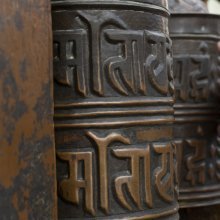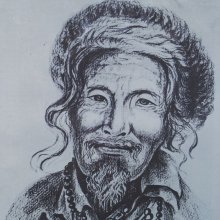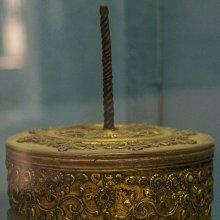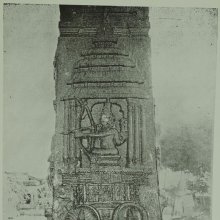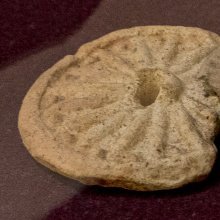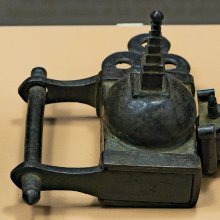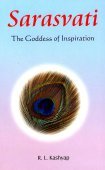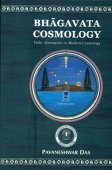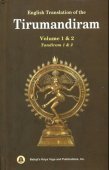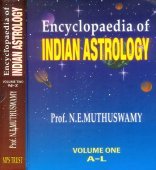Wheel: 2 definitions
Introduction:
Wheel means something in Buddhism, Pali, Hinduism, Sanskrit. If you want to know the exact meaning, history, etymology or English translation of this term then check out the descriptions on this page. Add your comment or reference to a book if you want to contribute to this summary article.
Images (photo gallery)
(+32 more images available)
In Hinduism
Natyashastra (theatrics and dramaturgy)
Source: Shodhganga: Elements of Art and Architecture in the Trtiyakhanda of the Visnudharmottarapurana (natya)The Wheel is associated with Mṛgaśīrṣa-hasta: one of the twenty-two Single-hand Gestures (in Indian Dramas) (known as asaṃyuktahastas), according to the Viṣṇudharmottarapurāṇa, an ancient Sanskrit text which (being encyclopedic in nature) deals with a variety of cultural topics such as arts, architecture, music, grammar and astronomy.—The word mṛgaśīrṣa is the union of two words viz., mṛga and śīrṣa. The word mṛga means deer and śīrṣa means head. So, it can be said that the hand posture which is called mṛgaśīrṣa identifies a posture that looks like the head of a deer. [...] In the Abhinayadarpaṇa, the mṛgaśīrṣa-hasta posture is used to denote various things. This book states that this posture is used to show woman, cheek, wheel, limit, terror, quarrel, attire and to call someone or the beloved, the lute, foot massage, female organ, holding umbrella etc.

Natyashastra (नाट्यशास्त्र, nāṭyaśāstra) refers to both the ancient Indian tradition (shastra) of performing arts, (natya—theatrics, drama, dance, music), as well as the name of a Sanskrit work dealing with these subjects. It also teaches the rules for composing Dramatic plays (nataka), construction and performance of Theater, and Poetic works (kavya).
In Buddhism
Tibetan Buddhism (Vajrayana or tantric Buddhism)
Source: OSU Press: Cakrasamvara SamadhiWheels (in Sanskrit: cakra) refers to the “energy systems along the center of the spine” in Tantra.—Many of the techniques used by Tantra are what latter became known as Hatha Yoga, such as meditations based on the cakras, "wheels", the energy systems along the center of the spine, nāḍīs, "tubes", the energy channels that run throughout the entire body, and kuṇḍalinī, "the coiled snake", a set of breathing techniques for generating internal heat, elevating one's life force (vīrya), and injecting it into the central channel. These Yogic practices were combined with sādhanā, "the act of mastery", a daily or periodic practice of communing with the divine, usually through the visualization and worship (pūjā) of divine beings, [...].

Tibetan Buddhism includes schools such as Nyingma, Kadampa, Kagyu and Gelug. Their primary canon of literature is divided in two broad categories: The Kangyur, which consists of Buddha’s words, and the Tengyur, which includes commentaries from various sources. Esotericism and tantra techniques (vajrayāna) are collected indepently.
See also (Relevant definitions)
Starts with: Wheel cactus, Wheel Of Law, Wheel Of The Law, Wheel Turning King, Wheel-rolling King, Wheel-turning King, Wheelwright.
Full-text (+2198): Cakra, Nemi, Kalacakra, Dharmacakra, Nabhi, Ara, Cakravat, Rathacakra, Rathacarana, Dalbha, Cakka, Brahmacakra, Rathanga, Cakranabhi, Tricakra, Cakragoptri, Pradhi, Saptacakra, Rahata, Shricakra.
Relevant text
Search found 340 books and stories containing Wheel; (plurals include: Wheels). You can also click to the full overview containing English textual excerpts. Below are direct links for the most relevant articles:
Rig Veda (translation and commentary) (by H. H. Wilson)
Guhyagarbha Tantra (with Commentary) (by Gyurme Dorje)
Text 4.13 (Commentary) < [Chapter 4 (text and commentary)]
Text 4.27 (Commentary) < [Chapter 4 (text and commentary)]
Chapter 10 - Conferral of Empowerment < [Chapter 10 (Text and Commentary)]
Asvalayana-grihya-sutra (by Hermann Oldenberg)
Prashna Upanishad with Shankara’s Commentary (by S. Sitarama Sastri)
Verse 1.11 < [Prashna I - The spiritual paths of the Moon and the Sun]
Verse 6.6 < [Prashna VI - The Purusha of sixteen Kalas (parts)]
Verse 2.6 < [Prashna II - Discussion of Devas]
The Shiva Purana (by J. L. Shastri)
Chapter 8 - The detailed description of the chariot etc. < [Section 2.5 - Rudra-saṃhitā (5): Yuddha-khaṇḍa]
Chapter 15 - The idol of Śiva for worship < [Section 6 - Kailāsa-saṃhitā]
Chapter 24 - Jalandhara is slain < [Section 2.5 - Rudra-saṃhitā (5): Yuddha-khaṇḍa]
Bodhisattvacharyavatara (by Andreas Kretschmar)
Khenpo Ape’s Advice On Studying The Bodhisattva-caryāvatāra < [Introduction Text]
Text Section 75 < [Khenpo Chöga’s Oral Explanations]
Text Sections 272-273 < [Khenpo Chöga’s Oral Explanations]
Related products
